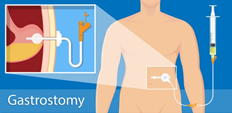The main types are percutaneous endoscopic gastrostomy (PEG) and radiologically inserted gastrostomy (RIG). Others include a surgically placed gastrostomy tube or a low-profile gastrostomy. If your gut does not work, a percutaneous endoscopic gastrojejunal gastrostomy (PEGJ) or a surgically placed jejunostomy (JJ) is used.

Image credit: Shutterstock
Percutaneous endoscopic gastrostomy (PEG)
A soft, flexible tube that has a camera and a light (endoscope) is passed down your food pipe into your stomach. A small opening (stoma) is made through the skin of your abdomen into your stomach. The tube is secured in your stomach with a bumper.
Radiologically inserted gastrostomy (RIG)
A thin flexible tube (nasogastric tube) is passed down your nose directly into your stomach. Air is pushed into your gut through the tube in your nose. After your belly is numb, an area is formed to fit the feeding tube. A radiologist will use x-ray guidance to place the tube. It is held in place with stitches and 2 or 3 buttons on the skin near your stomach. These buttons will fall off after a few weeks as the stitches dissolve. A balloon filled with water inside your stomach keeps the tube in place.
Percutaneous endoscopic gastrojejunal gastrostomy (PEGJ)
A PEG is placed as described above. A jejunal tube is then inserted through the PEG tube and into the jejunum (a part of your small intestine).
Surgically placed gastrostomy (G-tube) or jejunstomy (JJ)
This is placed by a surgeon in your gut or intestine while you are put to sleep with anaesthetic.







